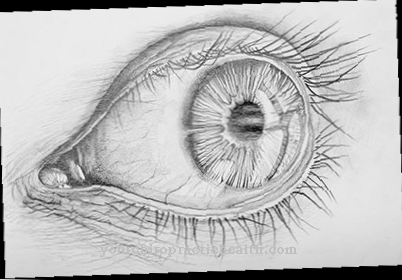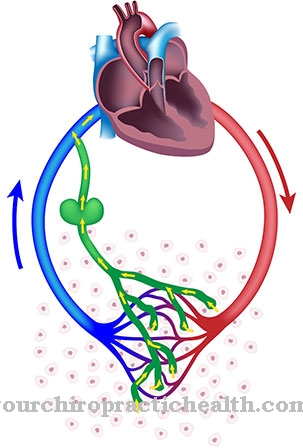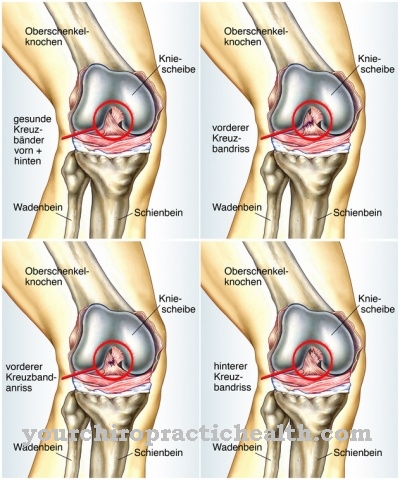Under the complete androgen resistance Doctors understand a mutation that produces female phenotypes from male karotypes. The patients have a blind vagina and their testicles are affected by testicular dystopia. The testicles are removed before the age of 20 to reduce the risk of degeneration.
What is complete androgen resistance?

© MQ-Illustrations - stock.adobe.com
The complete androgen resistance is also known as Goldberg-Maxwell-Morris Syndrome and is a form of intersexuality caused by a peripheral hormone receptor disorder. The receptor defect is genetic and corresponds to a complete resistance of the androgen receptors. Testosterone therefore has no effect on the body.
This phenomenon manifests itself in an absolutely feminine figure, although the genetic diamond corresponds to that of a man. Patients have blind-ended vaginas and their testicles are usually affected by testicular dystopia. In almost all cases, the gender of those affected is female. About one in 20,000 people is born with complete androgen resistance.
causes
In the case of complete androgen resistance, a defect is localized on the long arm of the respective X chromosome (Xq11). This defect corresponds to a mutation of the coding gene for androgen receptors. Usually the mutation corresponds to a point mutation that changes the amino acid sequence. This changes the molecular structure of the androgen receptors, so that hormone binding is no longer possible. Because of the lack of testosterone binding, a pseudo-female phenotype develops.
In some patients, instead of a point mutation, it is also a mosaic mutation, so that the affected person has cell populations with mutated and faultless androgen receptors at the same time. Environmental toxins such as bisphenol A are currently being discussed as the cause of the mutation. The defect can be passed on as an X-linked recessive inheritance.
Symptoms, ailments & signs
Most patients with complete androgen resistance will undoubtedly be judged as girls at birth. Sometimes patients are taller than average at birth. The testicles are often located inside the abdomen or in the groin area. This means testicular dystopia, which can be detected by palpation shortly after birth if necessary. The created vagina remains shortened and has a blind end.
Neither the patient's uterus nor fallopian tubes develop in the course of life. Otherwise the female development is not disturbed. Breasts do develop. The armpit and pubic hair remain, however, so that those affected are often referred to as hairless women. During puberty, people who are completely androgen-resistant have no menstrual bleeding due to the lack of genital organs.
Diagnosis & course of disease
The diagnosis of complete androgen resistance is often not made before puberty. Usually it is only the lack of menstruation that arouses initial suspicion. Sometimes the affected person only moves to see a doctor if they have not wanted to have children. If the diagnosis is made immediately after birth, it is usually because of a bulge on the groin or the labia majora.
This protrusion corresponds to an undescended testicle and can be recognized as such by means of ultrasound. To confirm the diagnosis, a laboratory creates a karyogram from the patient's serum. When making a diagnosis, the doctor must be sensitive and, if necessary, provide the person concerned with psychotherapeutic help.
Complications
With complete androgen resistance, there are various complaints. As a rule, there are not only physical but also severe psychological complaints. Patients feel very uncomfortable with their body and can be ashamed of it. It is not uncommon for depression or other psychological upsets to occur.
There are strong characteristics of a woman that can lead to mood swings and inferiority complexes in a man. It is also not uncommon for the genital organs to be absent and puberty either does not occur or occurs very delayed. The patient's quality of life is severely restricted and reduced by the complete androgen resistance. The risk of testicular cancer also increases enormously, so that there may be a reduced life expectancy for the patient.
Treatment of complete androgen resistance does not usually lead to particular complications or complaints. The testicles can be removed with the help of an operation. A vagina can also be created so that the person concerned can also take part in sexual intercourse. It is not uncommon for the patient to undergo psychological treatment, although the parents or relatives can also be affected by this disease.
When should you go to the doctor?
If a complete androgen resistance is suspected, the gynecologist or urologist must be consulted. Young women who have no menstrual period at the beginning of puberty or who have a delayed menstrual period should seek medical advice. The same applies to young men who do not develop testicles or who develop small testicles during the growth phase. Complete androgen resistance does not always have to cause symptoms or complications, which is why a medical examination is not necessary in every case.
Usually, however, there are physical and psychological complaints that need to be treated. A full sex life can only be achieved through early and usually protracted therapy. In the best case scenario, the disease is recognized before puberty begins. Then hormone therapy can be initiated in good time and female development can be optimally promoted. Various side effects can occur during treatment and the patient should therefore consult their doctor closely. The medical professional must be informed of any unusual symptoms. Even after the initial treatment, regular check-ups by the gynecologist are necessary.
Treatment & Therapy
Undescended testicles are associated with a risk of degeneration. For those affected, the risk of malignant testicular cancer is usually 32 times higher than for healthy people. Therefore, testicular dystopia must be corrected surgically in most cases. Especially testicles in the abdomen, as they are most common in androgen-resistant people, degenerate with a probability of 25 percent, as the ambient temperature at this point favors the degeneration.
Usually incorrectly placed testicles are removed or placed in the correct place in the first few years of life. This usually does not apply to those who are completely androgen-resistant. A castration and with it the removal of the testicles does not normally take place before puberty. However, removal before the age of 20 is medically recommended. Only if the testicles are preserved for as long as possible does puberty not have to be induced artificially.
The testosterone produced is converted to estrogen during puberty and female development can take place naturally in this way. In addition, the supportive administration of estrogens is often used therapeutically. This ensures a clear development towards women. After the testicles have been removed, it is often advisable to give estradiol, which also reduces the risk of osteoporosis and protects the hair and skin and promotes the feminine appearance.
In some people with complete androgen resistance, the shortened vagina has to be enlarged at some point in life. Surgical vaginal augmentation is the only way for some patients to have painless sexual intercourse.
You can find your medication here
➔ Medicines for potency and erection problemsOutlook & forecast
The prognosis for the rare, hereditary complete androgen resistance - also known as Goldberg-Maxwell-Morris syndrome - is difficult. The women affected are basically of two genders. But only one thing can be seen from the outside.
The sexual characteristics of the opposite sex are hidden. this is potentially dangerous. Male sexual characteristics are therefore often surgically removed at a young age. If this does not happen, many medical professionals see a worse prognosis. Testicles located inside the body or male sexual characteristics are said to have a tendency to degenerate through heating beyond a certain tolerance limit.
Whether women with complete androgen resistance feel more masculine because of the masculine gender attributes is not known. Therefore, the prognosis for a happy life as a woman is not necessarily worse. However, the lack of a uterus is very stressful for some women. A desire to have children will not come true. Some women with complete androgen resistance suffer from hormone therapy with estrogens. The administration of testosterone preparations is prohibited.
Six medical centers are currently searching for better hormone therapies and treatments for complete androgen resistance. The results of this double-blind study should improve the quality of life of those affected. The medical prognosis is good these days, but the social one is not. Intersex people continue to feel discriminated against, even if a third gender has now been introduced.
prevention
Complete androgen resistance cannot be prevented, because this disease is a mutation. Prevention is difficult because it has not yet been conclusively researched which factors are relevant for this mutation. However, expectant parents may be able to obtain certainty about the mutation of the fetus as part of a prenatal molecular genetic diagnosis.
Aftercare
For this disease, the follow-up measures are very limited. In many cases, they are usually not available to the person affected, so that the disease itself must be treated properly in the first place. Only through appropriate treatment and an early diagnosis can further complaints and complications be prevented, so that the person affected should ideally see a doctor at the first signs and symptoms of the disease.
Since the disease is usually caused by a tumor, the first thing to do is to remove it completely. Even after the successful removal, the person concerned should be examined regularly by a doctor to prevent degeneration and the recurrence of the tumors.
Likewise, with this disease it is usually necessary to take various medications, whereby care must be taken to ensure the correct dosage and correct intake. If anything is unclear or if you have any questions, a doctor should always be consulted first. Parents must properly monitor the use of the medication and the progress of treatment, and a doctor should be consulted regularly, especially during puberty.
You can do that yourself
Patients with complete androgen resistance may be under constant medical care from an early age, have had one or more sex reassignment surgeries, and / or need to take hormones constantly. All of this requires not only great adherence to therapy, but also psychological stability. The constant feeling of "being different" can wear down in the long run. Often times, depression and anxiety are the result.
These patients therefore need psychological support even more than medical care. It is also helpful to join self-help groups and thus to have contact with women who have the same fate. Here, for example, the self-help group “XY women” with its respective sub-groups “SHG XY women” and “SHG parents XY women” is recommended. Only the personal stories that are published on the website can reduce possible fear of the threshold. The umbrella organization "Intersexuelle Menschen e.V." also offers so-called peer counseling. This means that "same people advise", that is, those affected help others affected. This service is free. The members of the association even offer to visit those looking for help at their place of residence and to advise them on site.
For some women, it helps to put on make-up or dress in a particularly feminine way so that they no longer have the feeling that they are different from others. It is also advisable to incorporate small islands of wellbeing into everyday life.

.jpg)

























